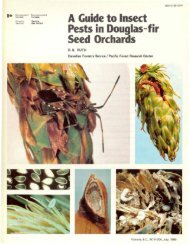Note Aceria parapopuli - Canadian Forest Service
Note Aceria parapopuli - Canadian Forest Service
Note Aceria parapopuli - Canadian Forest Service
Create successful ePaper yourself
Turn your PDF publications into a flip-book with our unique Google optimized e-Paper software.
<strong>Note</strong><br />
CANADIAN JOURNAL OF PLANT PATHOLOGY 16: 199-201. 1994<br />
Perennial stem galls of aspen caused by the poplar budgall mite, <strong>Aceria</strong> <strong>parapopuli</strong><br />
(Acariformes:Eriophyidae)<br />
Patricia E. Crane and Y. Hiratsuka<br />
Department of Plant Science, University of Alberta, Edmonton, Alberta T6G 2M7; and Northern <strong>Forest</strong>ry Centre, Natural Resources<br />
Canada. 5320 - 122 Street, Edmonton, Alberta T6H 355.<br />
Corresponding author, P.E. Crane; current address: Northern <strong>Forest</strong>ry Centre, Natural Resources Canada, 5320 - 122 Street.<br />
Edmonton, Alberta T6H 355 (Telephone (403) 435-7210; Fax (403) 435-7359).<br />
Accepted for publication L 994 06 07<br />
Large, black perennial trunk galls occur on trembling aspen (Populus tremuloides) in localized areas of Alberta and British<br />
Columbia. The cause of many of these galls is unknown, but some galled trees have been previously shown to be less likely to<br />
have advanced decay caused by Phellinus tremulae than are surrounding nongalled trees. In a large area of trees with mUltiple<br />
stem galls near Dawson Creek, British Columbia, the surface morphology of galls differed from that of galls occurring in central<br />
Alberta. The Dawson Creek galls had succulent red tissue proliferations on the surface that contained poplar budgall mites<br />
(<strong>Aceria</strong> <strong>parapopuli</strong>), which normally occur on aspen twigs, but rarely on stems. The trees in this study appear to be of one clone<br />
and, from examination of the internal gall morphology, have likely been continuously inhabited by mites for many years. The<br />
potential of these mites to induce resistance against decay needs further study.<br />
Crane, P.E., and Y. Hiratsuka. 1994. Perennial stem galls of aspen caused by the poplar bud gall mite, <strong>Aceria</strong> <strong>parapopuli</strong><br />
(Acariformes:Eriophyidae). Can. J. Plant Pathol. 16:199-201.<br />
Dans certaines regions de I' Alberta et de la Colombie-Britannique, on trouve de larges galles noires permanentes sur la tige du peu<br />
pliers faux-tremble (Populus tremuloides). On ignore la cause de la formation de bon nombre de ces galles, mais il a deja ete demontre<br />
montre que certains arbres atteints risquent moins de parvenir a un stade avance de la pourriture causee par Ie Phellinus tremulae<br />
que des arbres avoisinants et non porteurs de galles. Pres de Dawson Creek, en Colombie-Britannique, on a etudie un vaste secteur<br />
ou se trouvent des arbres porteurs de nombreuses galles sur les tiges dont la morphologie de surface difrere de celle des galles<br />
observees sur des arbres du centre de I' Alberta. Les galles de Dawson Creek etaient formees de proliferations de tissu rouge succu<br />
lent en surface et qui contenaient des phytotes du bourgeon du peupJier (<strong>Aceria</strong> <strong>parapopuli</strong>), qui sont normalement trouves sur les<br />
brindilles du peuplier faux-tremble, mais rarement sur la tige. II semble que les arbres de cette etude appartiennent a un meme clone<br />
et, a l'examen de la morphologie interne des galles, que les phytotes s'y sont installes en permanence depuis bon nombre d'annees.<br />
Le potentiel qu'ont ces phytotes d'induire une resistance contre la pourriture merite d'etre etudie davantage.<br />
Trembling aspen (Populus tremuloides Michx.) is<br />
prone to many types of stem deformities. Large black<br />
stem galls occur on aspen stems in localized groups<br />
in central and northern Alberta, British Columbia<br />
(Crane 1993), and Colorado (Hinds 1985, Juzwik et<br />
al. 1978). Hinds (1985) suggested that they are<br />
insect-related; Peterson and Peterson (1992) claimed<br />
that they consist of raised callus tissue resulting from<br />
superficial wounds. Aspen with large black stem galls<br />
are less likely to have advanced decay caused by<br />
Phellinus tremulae (Bond.) Bond. & Boriss.<br />
(Hiratsuka & Loman 1984, Crane et al. 1994). This<br />
white-rot fungus is the most common cause of<br />
heartrot in aspen and the most severe limitation on<br />
the economic utilization of this tree species (Thomas<br />
et al. 1960, Hiratsuka & Loman 1984, Cheyne 1990).<br />
A morphological and anatomical study has shown<br />
that there are likely several causes for large black<br />
stem galls on aspen (Crane 1993). The purpose of this<br />
communication is to report the cause of one type of<br />
perennial stem gall.<br />
An area of about 10 ha of aspen with galls on more<br />
than 80% of the trees was found near Dawson Creek,<br />
199<br />
British Columbia (approx. 55°N 121°W). The galls<br />
occurred on both branches and stems, with stem galls<br />
often greater than 0.6 m across (Figs. 1, 2). These<br />
galls were unusual in having numerous red succulent,<br />
cauliflower-like proliferations on the surface (Fig. 3).<br />
These contained many eriophyid mites that were<br />
identified as the poplar budgall mite, <strong>Aceria</strong> <strong>parapopuli</strong><br />
Keifer ( = Eriophyes <strong>parapopuli</strong> Keifer). It was<br />
also determined that dried stem galls previously col<br />
lected from Hinton and Whitecourt, Alberta, were<br />
also most likely caused by this mite because they<br />
bore similar proliferations of surface tissue. It was<br />
also possible to dissect out older proliferations with<br />
characteristic hairy surfaces from wood of previous<br />
years. It is therefore believed that A. <strong>parapopuli</strong> is the<br />
primary causal agent of these galls rather than a sec<br />
ondary invader.<br />
The poplar bud gall mite, described by Keifer in<br />
1940, occurs throughout western North America,<br />
principally on the great plains and in the intermoun<br />
tain region (Jeppson et al. 1975), on various poplars,<br />
including aspen, cottonwoods, and hybrids. A similar<br />
mite, Eriophyes populi (Nal.), occurs on Populus
200 CANADIAN JOURNAL OF PLANT PATHOLOGY, VOLUME 16, 1994<br />
Figures 1-3. Aspen galls caused by the poplar budgall mite (<strong>Aceria</strong> <strong>parapopuli</strong> Keifer) near Dawson Creek,<br />
British Columbia; 1) Aspen trees with numerous stem galls; 2) Three large galls on one tree; 3) Close-up of<br />
gall showing red succulent tissue proliferations on the surface. This tissue contains living mites.
tremula L. and P. nigra L. in Europe (Wilson &<br />
Oldfield 1966). Galls caused by <strong>Aceria</strong> <strong>parapopuli</strong><br />
are persistent and are generally found ringing the<br />
base of a developing bud or shoot (Keifer et al.<br />
1982). Mites occupy galls for 1-4 years, or in rare<br />
cases, up to 10-15 years (Ives & Wong 1988). A 12-<br />
year-old mite-caused stem gall was reported from<br />
Miette Hot Springs, Alberta (Campbell et al. 1969).<br />
In the present study, stem galls from Hinton thought<br />
to be caused by this mite were at least 40 years old,<br />
and some of those from Dawson Creek are likely<br />
more than 80 years old. The irregular, cauliflower<br />
shape of the galls occurs because different areas have<br />
been inhabited by the mites at different times, induc<br />
ing abnormal surface proliferation and localized<br />
hyperplastic growth of the sapwood. A morphologi<br />
cal study of these galls and comparison with similar<br />
galls of unknown cause has been done (Crane 1993).<br />
It is impossible to determine at this time whether<br />
mite-infested aspen trees have a lower decay level than<br />
do surrounding nongalled trees because of the rare<br />
occurrence of large stem galls caused by the poplar<br />
budgall mite and a low incidence of Phellinus tremu<br />
lae at the site near Dawson Creek. The trees with mul<br />
tiple stem galls may represent an aspen clone that is<br />
particularly susceptible to poplar budgall mite. The<br />
potential of these mites as inducers of resistance mech<br />
anisms against decay organisms needs to be examined.<br />
We thank I.M. Smith, CLBRR, Biological Resources Division,<br />
Agriculture Canada, Ottawa, Ontario, for confirming the identifica<br />
tion of the poplar budgall mites. Voucher specimens have been<br />
deposited at CLBRR. We also thank R. Cooms and M. By!.<br />
Louisiana-Pacific Canada, Ltd., Dawson Creek, B.C., and D.<br />
Cheyne, <strong>Canadian</strong> <strong>Forest</strong> <strong>Service</strong>, for assisting with field surveys.<br />
Campbell, L.M., R.J. Bilodeau, and R.F. DeBoo. 1969. Research<br />
on the poplar gall-mite in the prairie provinces. Can. Dep. Fish.<br />
CRANE, HlRA TSUKA: ASPEN/STEM GALLS 20 I<br />
For., For. Branch, For. Res. Lab., Winnipeg, Manitoba. Internal<br />
Rep. MS-96.<br />
Cheyne, D.A. 1990. An introduction to market aspen bleached<br />
chemi-thermomechanical pulp. Pages 275-281 in R.D. Adams,<br />
ed., Proceedings of the aspen symposium '89, July 25-27, 1989,<br />
Duluth, Minnesota. USDA. For. Serv., North Cent. For. Exp.<br />
Stn., St. Paul. Minnesota. Gen. Tech. Rep. NC-140.<br />
Crane, P.E. 1993. Black gall on aspen: anatomy, histology, and<br />
relationship to decay. M .Sc. thesis, Department of Plant<br />
Science, University of Alberta. Edmonton. Alberta.<br />
Crane, P.E., P.V. Blenis, and Y. Hiratsuka. 1994. Black stem<br />
galls on aspen and their relationship to decay by Phellinus tremulae.<br />
Can. J. For. Res. (In press).<br />
Hinds, T.E. 1985. Diseases. Page 106 in N.V. DeByle and R.P.<br />
Winokur, eds., Aspen: ecology and management in the western<br />
United States. USDA. For. Serv .• Rocky Mtn. For. Range Exp.<br />
Stn., Fort Collins, Colorado. Gen. Tech. Rep. RM-I 19.<br />
Hiratsuka, Y., and A.A. Loman. 1984. Decay of aspen and bal<br />
sam poplar in Alberta. Environ. Can., Can. For. Serv., North.<br />
For. Res. Cent., Edmonton, Alberta. Inr. Rep. NOR-X-262.<br />
Ives, W.G.H., and H.R. Wong. 1988. Tree and shrub insects of<br />
the prairie provinces. For. Can., Can. For. Serv .. North. For.<br />
Cent., Edmonton, Alberta. Inf. Rep. NOR-X-292.<br />
Jeppson, L.R., H.H. Keifer, and E.W. Baker. 1975. Mites injuri<br />
ous to economic plants. University of California Press,<br />
Berkeley.<br />
Juzwik, J., W.T. Nishijima, and T.E. Hinds. 1978. Survey of<br />
aspen cankers in Colorado. Plant Dis. Rep. 52:906-910.<br />
Keifer, H.H. 1940. Eriophyid studies VIII. Bull. California Dep.<br />
Agric. 29:21-46.<br />
Keifer, H.H., E.W. Baker, T. Kono, M. Delfinado, and W.E.<br />
Styer. 1982. An illustrated guide to plant abnormalities caused<br />
by eriophyid mites in North America. USDA, Agric. Res. Serv.,<br />
Agric. Handb. 573.<br />
Peterson, E.B., and N.M. Peterson. 1992. Ecology, management,<br />
and use of aspen and balsam poplar in the prairie provinces,<br />
Canada. For. Can., Can. For. Serv., North. For. Cent.,<br />
Edmonton, Alberta. Spec. Rep. I.<br />
Thomas, G.P., D.E. Etheridge. and G. Paul. 1960. Fungi and<br />
decay in aspen and balsam poplar in the boreal forest region,<br />
Alberta. Can. J. Bot. 38:459-466.<br />
Wilson, N.S., and G.N. Oldfield. 1966. New species of eriophyid<br />
mites from western North America, with a discussion of erio<br />
phyid mites on Populus. Ann. Entomol. Soc. Am. 59:585-599.


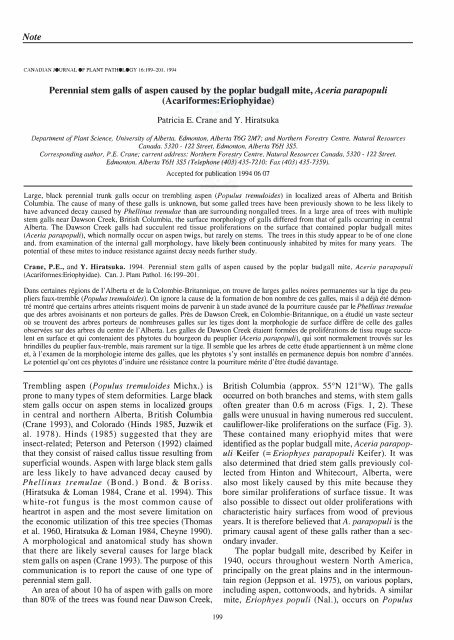
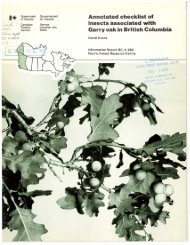
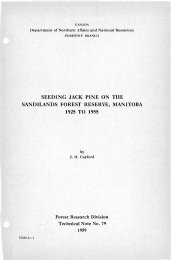
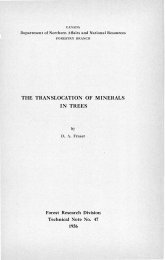
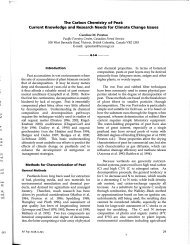


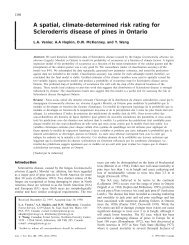

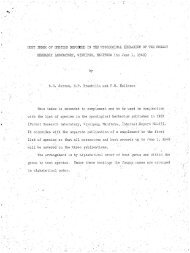
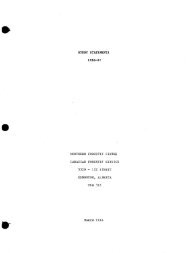
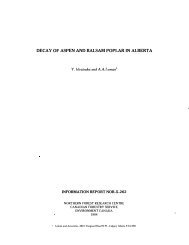
![Po],rell](https://img.yumpu.com/11946277/1/190x231/porell.jpg?quality=85)
